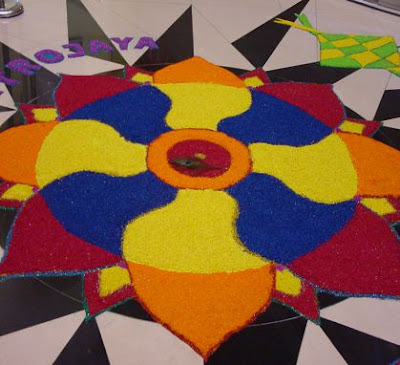Lit your diwali with rangoli design
Rangoli is a colourful pattern made near the entrance to a house to welcome guests.The term Rangoli is derived from words: rang (colour) and aavalli (row ) so rangoli is row of colours.Rangoli is also known as Rangoli kolam.
It is one of the most popular and traditional art forms in India In the evenings of festive occasions, when oil lamps are lit, and the atmosphere is cool and pleasant, such floral designs create the atmosphere of a well-planned divine garden. It is customary for Indian women to draw decorated feet of Laxmi – The Godess of weath, approaching her door bringing in good fortune for her devote family.
Most of the Rangoli designs are motifs of plants, flowers, leaves such as coconut, lotus, mango, and ashwath (peepal leaf), the animals such as cows, elephants, and horses, and the birds like eagles and swans. There are geometrical pattern as well. When drawn with fingers, these acquire different dimensions on their own.On the right side you will find useful links of Rangoli pattern. This diwali light up your house with Rangoli Kolam

Themes in rangoli designs
Kolam have many themes which keep changing according to the seasons and occasions.
Floral or natural theme :It is most common wth flower , leaves and vines running around
Insects theme :This includes fluttering butterflies too add to the beauty of flowers.
Religious theme : These are drawn with figures of the different deities/gods and goddesses
Festival theme : Made on festivals like Diwali ,Pongal and Onam. Consists of lamps and Diyas ,you will find heaps of Diwali Rangoli design on net .Bells and bows with Santa for Christmas
Contemporary: Rangoli pictures with live effects. What once began as geometrical religious symbolism, has thus blossomed into a delightful visual art with secular esthetic appeal.
Any type of design can be converted into Kolam , it just depends on your imagination.

Different names of Rangoli
In every region of India, it is known by different names :
Kerala : 'Puvidal' ( Puv means flower and idal means arrangement, i.e. Rangoli by flowers.
Tamil Nadu : 'Kolam' ( kolam - name of a specific quality of rice. Rangoli is drawn by using rice flour )
Andhra Pradesh : 'Muggu' ( Rangoli drawn by using thick batter of soaked rice flour )
Karnataka : 'Rangoli' ( From the powder of a special kind of a rock. Tiny dots are drawn on the floor usually in even numbers. These dots are joined with the powder in a geometrical fashion )
Maharashtra : 'Rangvalli' ( Rangoli thick powder made from special rock is used in various colors, and the powder of burnt rice skin is used to draw rangoli in Konkan part of Maharashtra )
Gujarat : 'Sathiya' ( Rangoli is known by this name )
Rajasthan : 'Mandana' ( rice flour mixed with little turmeric. It is drawn on the walls )
Madhya Pradesh : 'ChowkPurna' ( Traditional designs fitted in square with leaves and flowers )
Uttar Pradesh : It is known as 'Sona Rakhana'
Orissa : It is known as 'Ossa'
Almora - Garhawal : It is well popular known as 'Alpana'
Bengal : In Bengal it is drawn by soak rice paste and known as 'Apana'
With almost 'Four Hundred' names ,Rangoli designs and patterns are ultimately very attractive.Now just start and find Diwali Rangoli design.










.BMP)


